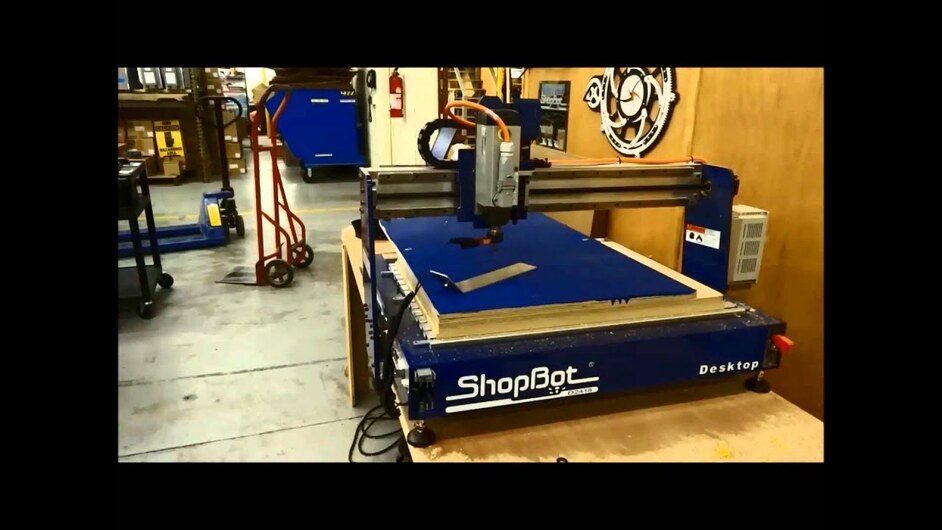No. The Pro is jut out there so I don’t think anyone has done one. Once I get mine I’ll do one if no one else has done one earlier (my ship date is the end of the month ![]() so sometime in Dec maybe for the video). It’s doable with a Basic but if you need to ask how you shouldn’t do it
so sometime in Dec maybe for the video). It’s doable with a Basic but if you need to ask how you shouldn’t do it ![]()
One technique that will work is using indexing pins. See this Shopbot video for the process.
There are other ways that use markings/scorings with similar markings on the bed or methods to use a fixed bed or machine position for the index so you don’t even need pins (that’s what I do on the Redsail - indexed off the back edge of the bed). Methods using marks on the bed/frame might be off a bit which probably wouldn’t matter for lots of things, but if you want real precision you’ll want to go with some pinning method. (There are other techniques with staggered locking jigs but the pin method will work fine.)
But for a quick and easy method the tiling with pins method will work for us. Since (I presume) the bed is at the same height as the bottom of the slot on the Pro, we can’t use a sacrificial base board so you’ll need to measure for your material pins based on where the holes lie in the crumb tray and then drop your pin thru your material and into a couple of holes in the tray. Get pins that fit snugly in the honeycomb cells. You can make those using acrylic or wood too. I think @takitus had a pin design he made from acrylic for hold-offs from the bed that could be modified (make the shaft longer) if you don’t want to make your own pin design.
For high precision work using the GF crumb tray as the base you’ll want to lock the tray in place so it doesn’t move as you move the material. That’s simple enough to create a piece of wood that will butt against the side and front/back of the machine that you then pin into the honeycomb. Your project material will butt against that piece so don’t make it more than an inch overlap onto the bed. The primary purpose is to keep the tray from moving so the pins in the tray and the material are going to be in the same relative position for the duration of the job. Your actual project material would now need to be 19x12. (Since it’s your own machine, you could also just make the locking butt piece only come to the inside edge of the black plastic housing on the tray and use a couple of finishing nails drilled into the edge to lock it in and then you’d have the full 20x12 bed to use. I don’t think that would void the warranty of your machine as it’s just a modification to the tray.)
You want to create a tiled set of 20x12 artboards so that your project pieces don’t need to be moved in the GFUI. You’d start by creating the project on something that is say 20x30". Then you’d break that into 3 20x10" sections that you put on your 20x12 artboards with the pin alignment as you measured. You’ll need to use your design software to break it up. They all have different methods of breaking a larger drawing into pieces. I think there’s a tutorial out there in the GF tutorial matrix because people are using that technique to break up very high res engraves into pieces that can be processed by the GF without running out of memory. If your bed locking piece overlaps the bed then you want to make sure your design is placed with that as a margin on the side.
Alternatively you can make your own bed for this work. I’d do it with 2 pieces of material - one to be used as the bed base and the second that would go on top and act as a sacrificial board where I’m going to drill my index pin holes as I switch out projects. The two pieces should be 1.4" tall (or whatever it is that your machine has for a bed height off the machine floor). You can also do this with a stack of 1/8 and 1/4" ply. If you use this method then you can use standard dowels or finishing nails for your pins. I like finishing nails because they don’t take much room diameter-wise on my material. (With the Redsail I can drop the bed to give it room for a sacrificial board on top of the bed in the machine that will be under the project material.) Since the GF is limited to 1/4" material, 8p finishing nails will provide more than enough strength to keep the material locked in place.
Does that help? It may take you a bit to puzzle it out but once you’ve done it the first time the light bulb goes off and it’s only an extra minute or two to modify the project and then to run the two (or more) drawing files into the machine moving the project to align with the pins each time.

 material delivery. I’ll give it a try. Thanks
material delivery. I’ll give it a try. Thanks
